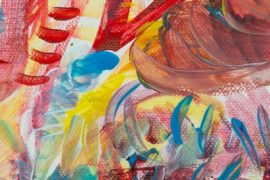As a semester defined by the disruption of COVID-19 was coming to a close, I remember reflecting on the wisdom of having set a task which asked students to reflect on the Great Barrier Reef as the ‘canary in the coal mine’ of climate change. Its sensitivity to changing ocean temperature as a result of global warming is demonstrated by the increasing incidence of coral bleaching events. As the semester was punctuated by yet another major bleaching event in March 2020, this fact was either well conveyed or naturally diffused in the minds of students growing accustomed to ‘living the Anthropocene’. Still debated among geologists as a way to classify a new geologically distinct time period, the Anthropocene is a term that has nonetheless gained broader cultural currency as a way of explaining a period of geological history defined by a significant rupture: the rise of humans as geological agents. As I parlayed the relevance of the concept through the lens of the environmental humanities, it was heartening to read students’ work critically validating the health of the reef as a barometer for the state of the biosphere; even seeing its degradation as a call to action on climate change.
The teaching challenges of environmental change

Reading close to 100 papers outlining what the Reef dying means was, however, a painful reminder that I am in no way resolved when it comes to the pedagogical challenge of ‘teaching the Anthropocene’. Teaching The Great Barrier Reef in the Age of the Anthropocene since the inception of the University’s Online Learning Environment (OLE) program in 2018 has sadly been an exercise in marking the Reef’s steady decline. Over the last decade alone, bleaching has left approximately half the Great Barrier Reef a barren wasteland of skeletal coral remains. This is on top of the more local disturbances caused by ongoing and touted industrial development. The Adani coal mine, in the initial phases of development, of course represents the dual threat of increased local disturbance and a massive rise in global emissions.
Teaching The Great Barrier Reef in the Age of the Anthropocene since the inception of the University’s Online Learning Environment (OLE) program in 2018 has sadly been an exercise in marking the Reef’s steady decline.
Testing my power of conveying this information objectively has been hampered by a building sense of despondency and helplessness. This emotional labour of teaching was enhanced by a creeping health and economic crisis, in and of itself a signifier of our changing and challenging relationship with the natural world on a global scale. A productive approach has been to engage students with the aesthetic loss posed by the Anthropocene, something neatly conveyed in the documentaries Chasing Coral and Chasing Ice. Both demonstrate the value of making the process of environmental change perceptually available (Quigley, 2019). But as I found, showing videos of calving ice sheets and dying coral can elicit a range of emotions – predilections of the sublime, terror, sadness as well as hope that such footage might prompt people to care more for the natural world.
The ‘who’ of pedagogy
How do we (should we) bring our inner lives, the ‘who’ of pedagogy, into talking about such monumental and unpredictable change? As teachers, can we let our emotions become involved in our explanation of key concepts, ideas and events? How fine is the balance between ‘objective’ fact and what might seem like narcissistic impulse? And perhaps most importantly, how and to what extent should such an emotionally activated pedagogy allow engagement with the inner lives of students? In most cases, by generational necessity they are the ones who will experience the Anthropocene at its most extreme. More than ever we are obliged to be receptive to how students are feeling, and not just thinking, about a changing world.
“At the very least we should all be seeking to validate the experiences of students as they navigate the ‘reality’ of things like climate change and the COVID-19 pandemic alongside their individual lived experiences of crises.”
COVID-19 has at the very least opened a space in learning environments where it seems possible, even pressing, to navigate mutual vulnerabilities and fears long called for by education scholars. A massive challenge presented by this opportunity is being open to the relational nature of the knowledge that we teach, of allowing for the reality that the facts we deliver are generated through our subjective, and emotional, engagement with the world. The cultural construction of knowledge is no doubt an easier path to navigate in some disciplines. At the very least we should all be seeking to validate the experiences of students as they navigate the ‘reality’ of things like climate change and the COVID-19 pandemic alongside their individual lived experiences of crises.
‘Affective adaptation’
From a pedagogical perspective this does not mean adopting the Anthropocene as a socially and geographically levelling concept, a ‘species-level’ event. Rather we should be encouraging ourselves and students to reflect upon our respective positions within the Anthropocene. Through such reflection we will realise that the questions of attribution and impact at the heart of global environmental change are socially, culturally and geographically contingent (Robin, 2018). In the case of the Great Barrier Reef, for instance, the love of country (and sea) denoted by Indigenous connections can’t be replicated in a non-Indigenous context. This will inevitably entail feelings of guilt, hopelessness and grief depending upon individual backgrounds. The term ‘solastalgia’ provides a broader means of processing grief for changing environments on a very local and personal scale. At once coming to terms with the Anthropocene might generate feelings of anger, or perhaps even pride in the immense scale of human agency among students. Whatever the emotion, ‘affective adaptation’ (Verlie, 2019) is a necessary if not sufficient task involved in the difficult process of ‘learning to live-with climate change’ and something we need to be thinking about more in all of our classrooms.





